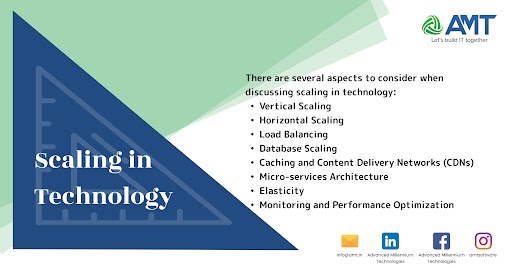Scaling in technology refers to the ability of a system, application, or infrastructure to handle increased workload or demand efficiently without compromising performance, reliability, or user experience. It involves expanding the capabilities of technology solutions to accommodate growing user bases, data volumes, transaction rates, or any other relevant metrics.
There are several aspects to consider when discussing scaling in technology:
- Vertical Scaling: Also known as scaling up, this involves increasing the capacity of existing hardware or software resources, such as upgrading a server’s CPU, memory, or storage capacity. Vertical scaling is typically limited by the maximum capacity of a single machine and can become expensive or impractical beyond certain thresholds.
- Horizontal Scaling: Also known as scaling out, this involves adding more instances or nodes to a system to distribute the workload across multiple machines. Horizontal scaling can often be more cost-effective and provides better fault tolerance and resilience compared to vertical scaling. It’s a common approach in cloud computing environments where resources can be dynamically provisioned and de-provisioned based on demand.
- Load Balancing: Load balancing distributes incoming network traffic across multiple servers or computing resources to ensure no single server becomes overwhelmed. This helps achieve better utilization of resources and improves system reliability and fault tolerance.
- Database Scaling: Scaling databases involves strategies to handle increased data volumes and transaction rates. This can include techniques such as sharding (partitioning data across multiple databases), replication (creating copies of data across multiple nodes), or using distributed databases designed for horizontal scalability.
- Caching and Content Delivery Networks (CDNs): Caching frequently accessed data or content at various layers of the technology stack, such as in-memory caching, database caching, or CDN caching, can help reduce the load on backend systems and improve response times for users.
- Microservices Architecture: Breaking down large, monolithic applications into smaller, loosely coupled services allows for independent scaling of different components based on their individual resource requirements and workload patterns.
- Elasticity: Elasticity refers to the ability of a system to automatically provision and de-provision resources in response to changing demand. Cloud computing platforms often provide elastic scaling capabilities, allowing organizations to scale resources up or down dynamically based on workload fluctuations.
- Monitoring and Performance Optimization: Continuous monitoring of system performance and utilization metrics is essential for identifying bottlenecks, optimizing resource usage, and proactively scaling infrastructure as needed to meet growing demand.
Overall, scaling in technology is a critical consideration for ensuring that systems can accommodate growth while maintaining performance, reliability, and cost-effectiveness. It requires careful planning, architecture design, and implementation of appropriate scaling strategies based on the specific requirements and constraints of the application or service.
Here are some additional aspects and considerations related to scaling in technology:
- State Management: When scaling horizontally, managing the state becomes a challenge because different instances or nodes may have different states. Designing stateless components or using external state management solutions such as distributed caches or databases can help mitigate this challenge.
- Data Consistency and Concurrency: In distributed systems with multiple nodes or replicas, ensuring data consistency and handling concurrent updates becomes crucial. Techniques such as distributed locking, optimistic concurrency control, or eventual consistency models can be employed to maintain data integrity while scaling horizontally.
- Auto-scaling: Auto-scaling enables automated adjustment of resources based on predefined policies or rules. This allows systems to dynamically scale up or down in response to changes in workload patterns, minimizing manual intervention and ensuring optimal resource utilization.
- Failure Handling and Redundancy: As the number of components or nodes increases in a scaled-out system, the likelihood of failures also increases. Implementing redundancy, fault tolerance mechanisms, and graceful degradation strategies are essential to ensure high availability and reliability in the face of failures.
- Network and Communication Overhead: Scaling out often involves communication between different components or nodes over a network, which can introduce latency and overhead. Optimizing network communication, minimizing data transfer, and using efficient protocols can help mitigate these challenges.
- Cost Considerations: While scaling horizontally can offer cost advantages compared to vertical scaling, it’s essential to consider the overall cost implications, including infrastructure costs, operational overhead, and licensing fees for any third-party services or software used for scaling.
- Predictive Scaling: Predictive scaling involves using historical data, trends, or predictive analytics to anticipate future demand and scale resources proactively before reaching capacity limits. This can help optimize resource provisioning and ensure smooth operation during peak periods.
- Scaling Beyond Traditional Boundaries: With the advent of technologies such as serverless computing, containerization, and edge computing, scaling beyond traditional boundaries becomes possible. These technologies offer new paradigms for dynamically allocating resources based on workload demands and geographic distribution.
- Regulatory and Compliance Considerations: In certain industries or regions, regulatory requirements or compliance standards may impose constraints on how data is stored, processed, or transmitted, impacting scaling strategies. Ensuring compliance with relevant regulations is essential when designing scalable systems.
- Culture and Organizational Considerations: Scaling technology also involves cultural and organizational aspects, such as fostering a culture of automation, DevOps practices, and cross-functional collaboration between development, operations, and other teams to support continuous scaling and improvement.
By considering these additional aspects alongside the fundamental principles of scaling in technology, organizations can build scalable, resilient, and cost-effective systems capable of meeting the evolving needs of users and businesses.
Above is a brief about Scaling in Technology. Watch this space for more updates on the latest trends in Technology.
